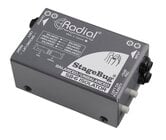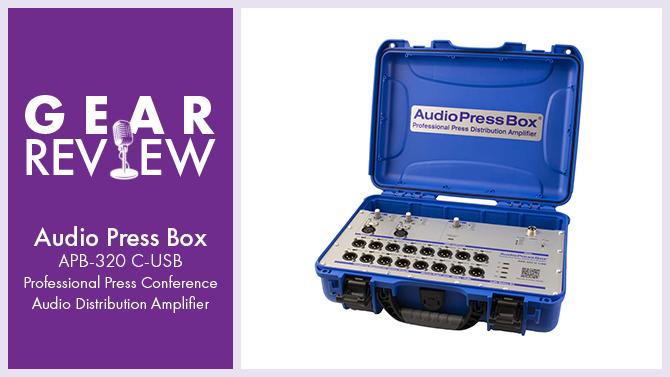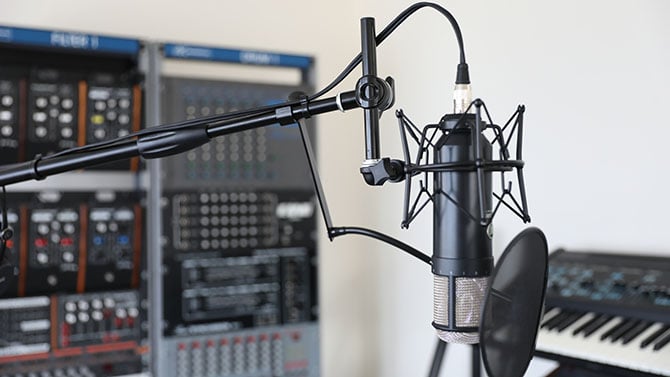The Radial Engineering StageBug® SB-6 is a high performance 2-channel Definition:
Definition:
1. In radio, television, citizen's band radio, and other wireless communications modes, a specific frequency for communication. 2. In mixers and video, an input or output signal path with controls. 3. In MIDI, one of 16 data paths. passive Definition:
Definition:
An electrical device or circuit whose parts require no power (e.g., there are no transistors or tubes). audio isolator designed to accommodate both balanced and unbalanced Definition:
Definition:
A two-conductor signal connection where one wire connects to ground. Unbalanced connections are prone to ground loop hum if equipment is not in close proximity. signals and work effectively at eliminating noise when used with instruments, consumer electronics as well as professional line-level devices.
The design begins with 1/4" TRS Definition:
Definition:
(Tip Ring Sleeve) Phone style connector. 3 conductor (Stereo) originally 1/4" diameter, also 1/8" and smaller and the TT style for patchbays. Used for headphones and patching. inputs and outputs to accommodate both TRS and mono Definition:
Definition:
Short for Monophonic. An audio program, recording, or hardware device/software routine that produces or processes a signal with only one channel. type connectors. The unique circuit retains the balanced signals or automatically converts them from hi-Z Definition:
Definition:
High impedance (Z stands for impedance). The input or output impedance is relatively high, although what is "relatively high" depends on the type of gear. High-impedance mic outputs range from 500-50,000 ohms, guitars pickups from 7,000 to 100,000 ohms (depending on frequency), and tube guitar amp inputs are typically 1,000,000 - 5,000,000 ohms. to lo-Z Definition:
Definition:
Z stands for impedance. See: Low Impedance. (1/4" mono to TRS) or lo-Z to hi-Z (1/4" TRS to mono) depending on the connector in use. You simply connect and the SB-6 does the work for you! Inside are two ultra-linear Eclipse transformers that sound great as they deliver ruler flat Definition:
Definition:
1. A frequency response curve that looks like a flat line because the response is even throughout the audio spectrum. 2. A scenic element like a wall or door. 3. A musical note that is lower in pitch than the note's standard frequency. See also: Sharp. performance from 20 Hz Definition:
Definition:
Abbreviation for Hertz. Unit of measurement for frequency, formerly called CPS (Cycles Per Second), that measures periodic waves, audio and radio frequencies, and mechanical repetitive motion. Example: 1000 Hz means a periodic waveform has 1000 cycles/vibrations per second. to 20 kHz Definition:
Definition:
Abbreviation for Kilohertz: 1,000 Hertz, or one thousand cycles per second.. This is augmented with a -10dB input pad Definition:
Definition:
1. (Passive Attenuation Device) A device that reduces (attenuates) the output of one device so it does not overload the next device in line. Typically either built-in to a condenser microphone after the capsule, a preamp, a mixer channel, or as a stand-alone, in-line accessory. 2. In music, a sustained, usually lush chord that provides a background sound to lead and harmony parts. to handle extra loud source devices and a polarity Definition:
Definition:
1. In electricity, the quality that indicates whether the pole of a direct current device like a battery has more electrons than the other (negative polarity) or fewer electrons than the other (positive polarity), which relates to the direction of current flow. 2. In audio, a reference to whether a point in a signal is above or below the zero voltage line (positive or negative, respectively). Reversing polarity "flips" a signal so that if a point in its waveform was positive, that point will be negative instead. Often confused with phase. See: Phase. reverse on output B for phase Definition:
Definition:
Sound waves are variations in air pressure that, like water waves, have peaks and troughs. Phase is the waveform's position in its current cycle. For example, if two versions of the same waveform are both at their peak, or at their trough, they're considered in phase. If one is at its peak and one is at its trough, they are considered out of phase. If one is at its peak and the other is at zero (between the peak and trough), then the two waveforms are 90 degrees out of phase. See also: Polarity aligning stereo Definition:
Definition:
A two channel signal simulating a sound space, typically played through two speakers. signals. As the circuit is passive, no power is required – simply plug Definition:
Definition:
A connector, normally male and attached to a cable. in and play. As with all Radial products, the SB-6 is made in Canada and features 16 gauge steel construction for use on the road and finished in a durable powder coat finish.
These features combine to make the SB-6 Isolator a wonderful solution to help rid system noise in two channel audio systems, stereo guitar racks and pedalboards.











